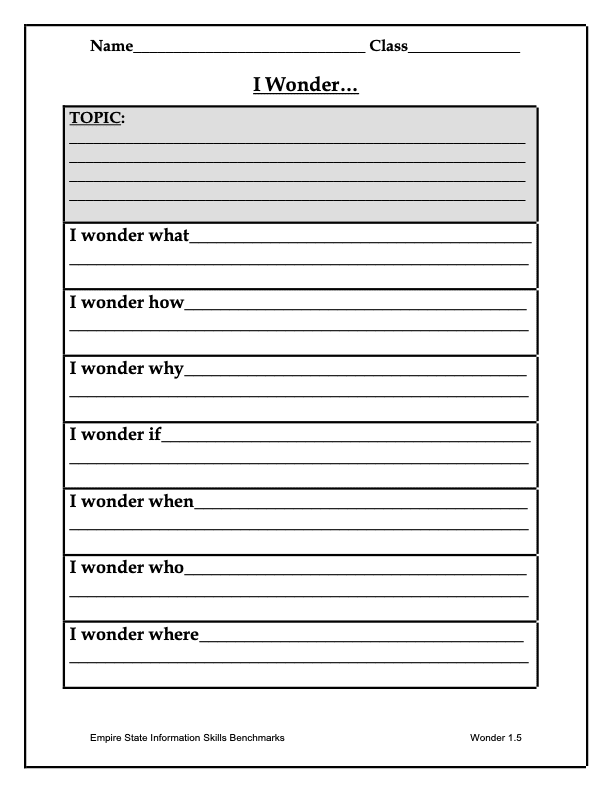Reply To: FOSIL in Primary School
Home › Forums › The nature of inquiry and information literacy › FOSIL in Primary School › Reply To: FOSIL in Primary School
Having spent time thinking and feeling my way into these topics and questions, I discussed them with Barbara (her post above is worth (re)reading).
These are my thoughts.
The essential question expresses a sense of wonder and puzzlement about the topic that gives rise to a process of inquiry, or finding out about the topic, which is learning about the topic. This is inquiry-based learning, and it does not always take place though a full inquiry that involves all 6 stages in the process. However, students will not develop in their ability to learn through inquiry if they never experience a full inquiry, which will depend on a number of things, including topic, time, and/ or resources. Either way, students need to be aware of the stages in the process, as well as which stage they are working in.
Reception (aged 4-5 / PK)
- Topic: Marvellous Me
- Question(s): Are we all the same? In what ways are we similar? In what ways do we differ from one another?
In response to this, the following priority skill for Reception stands out:
- Construct: With help, sorts and categorizes “like” and “different” objects.
This concept of similarity and difference is developed further in relation to self-identity elsewhere in the ESIFC, where, for example, identifying personal strengths and preferences (see PK.4 below, and used to connect) can serve as a starting point for wondering who has similar strengths and preferences, and who has different strengths and preferences. This might lead to wondering when it could be an advantage to be grouped together with people with similar strengths (such as a tug-of-war) or preferences (like a club), and when this could be a disadvantage, such as a relay race or general knowledge quiz. An investigation into some of these situations/ activities might be quite practical, and could lead to the construction of some interesting conclusions, which could then be expressed in a number of ways that celebrate commonality and diversity. Reflection could focus on how obvious differences can prevent us from discovering what we might have more deeply in common. An essential question that begins to emerge out of this for me is, “Wouldn’t it be great if everyone was just like me?”

Year 1 (aged 5-6 / K)
- Topic: Where do I live?
- Question(s): Is Guernsey an interesting place to live and visit?
This strikes me as an instance in which it would be helpful at the outset to have a clear idea of what the outcome of Express will in term of audience and product, as this will have some bearing on the specific shape that the inquiry takes.
It is interesting to me how this question builds on the concept of similarity and difference explored in Reception (see above) – some people are likely to share my preferences/ interests, but not all, which makes the topic of this inquiry a good example of situation in which it would an advantage to be in a group that is diverse in its interests. Consequently, identifying which outstanding feature(s) of Guernsey I would be interested in finding out more about (see K.1 below) – e.g., beaches/ coastline, wildlife, bunkers/ observation towers, etc. – would help to ensure a wide range of interests. This leads naturally to establishing facts (Investigate) about my specific feature (see K.5 below), which are then presented (Express) as compelling reasons for the inclusion of that feature (see K.8 below), bearing in mind audience and product. Reflection could include feedback on the product from a sample of the target audience.



Year 2 (aged 6-7 / Grade 1)
- Topic: Castles
- Question(s): Why did they build castles and what was life like inside a castle?
According to the Year 2 curriculum map, work on castles (History) followed work on scientists and inventors (Science). This led me to wonder whether it might be possible to approach the topic of castles from the perspective of innovators and innovations in castle design and construction. Background reading suggests that the history of castles does not include any stand-out innovators or breakthrough innovations, which a discussion with the Head of History confirmed. This, however, is itself telling, and may make for an interesting starting point for this inquiry, which is why history is silent about this.
Depending on the scope of the topic, and time constraints, it seems to me that Guernsey provides a fascinating insight into the development of castles through the ages (see, for example, Castles on the Guernsey Museums & Galleries website), which is partly due to its strategic signific and its small size. This might broaden out to consider the fortification of Guernsey through time – the most obvious example of this being stark evidence of the German occupation of Guernsey during World War II.
Connect is an interesting window into what students already know, or think they know (see 1.1 below), and the graphic organiser for Wonder encourages student questioning, either individually (see 1.4 below) or as a group (see 1.5 below). The topic and questions are well suited to establishing facts and forming opinions based on those facts (Investigate – see 1.8 below), and then using those facts to answer specific questions resulting from the essential question (Investigate – see 1.10 below).





This represents my thinking ahead of my initial meeting with the teachers of Reception, Year 1 and Year 2. Clearly, there is more work to be done following the meeting, specifically to ensure that the inquiries cover the topic in terms of requisite subject area content while also uncovering the depth and richness of a topic, and to establish what age-appropriate resources and graphic organisers will best support the inquiries.
I will post again at some point following my meeting.


